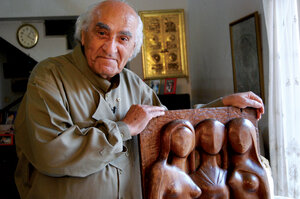Renowned Iraqi sculptor has vision for Baghdad to 'flower again'
Iraqi sculptor Mohammad Ghani is working on four new pieces of public art for Baghdad, one of which will include bronze calligraphy from a poem by Mustafa Jamal al-Din.

Mohammad Ghani with a piece that was given to him after being looted in 2003 from Iraq’s national art museum. It is one of two bought by an Iraqi for safekeeping and given to the sculptor when he came back to Baghdad.
Jane Arraf
Baghdad
Mohammad Ghani, one of Iraq's pioneering artists, barely recognizes the Baghdad he left seven years ago.
"When I left Baghdad I never thought I would stay away so long," says Mr. Ghani, on his first trip back to the city he loves since he escaped the postinvasion violence here. Driving through streets choked with concrete barriers, bombed buildings, and trash, his eyes tear up.
"Baghdad is like a beautiful woman, dressed in white … but now ... her hair is dirty, her dress is dirty," says Ghani, whose career as a sculptor spans 60 years. "I don't want to, but it makes me cry."
He says he was afraid to return but was persuaded by the mayor of Baghdad, who has commissioned him to do four new sculptures as part of the revitalization of the city.
Ghani, who studied art in Rome, created many of Baghdad's best-known landmarks, including the huge public sculptures inspired by the fables of "One Thousand and One Nights": On a busy square in central Baghdad, his statue of Kahramana, in the middle of a fountain lit by garish green lights, pours oil on some of the 40 thieves hiding in jars.
Outside the government-owned Rashid Hotel, an astonished fisherman beholds a genie – a wisp of smoke transformed into a sinuous and powerful woman cast in bronze. And on Baghdad's Abu Nuwas Street, named after one of the most famous Abbasid poets, Shehrazad holds the rapt attention of a lounging King Shahryar.
The artist's work and his life have spanned Iraq's recent history. At the Church of the Ascension, for the first time in a decade, Ghani gazes at Stations of the Cross, carved in stone in a combination of the Assyrian bas-reliefs of Ninevah and his own style.
In the rectory kitchen, a relative of one of the most recent victims of the killings of Christians in Baghdad prepared coffee. There are few worshipers left but Ghani recalls that in the Iraq that he knew, even Muslims came to the church to pray.
"I carved these in 1991; at the same moment I was carving, the bombs started to fall," says Ghani, his eyes again filling with tears as he recalls the destruction after the former regime's invasion of Kuwait.
His new works include bronze calligraphy from a poem by Mustafa Jamal al-Din that he plans to install in old Baghdad – the site of the original walled city.
"It says 'Baghdad, no matter what happens to you, you will always flower again,' " says Ghani. "I found this poem carved over his tomb in Damascus. When I read it, at that moment, I promised him I would do it as a fountain in Baghdad."
In his dozens of sculptures throughout the city, gowns cling to voluptuous female forms – unusual in the Arab world. In countries with strict Sunni traditions, depicting human or animal forms, let along barely clothed women, is considered blasphemous.
But "this is the Iraqi character," Ghani says. "They appreciate artists; they like sculpture."
Once, when he was working on a 20-foot statue in his tiny studio, he had to block the roads and complete it in the street. Instead of complaining, the neighbors brought his assistants food and tea, he says.
Ghani himself seems a part of Iraq's lost history. People stop him in the street to shake his hand and pose with him for photographs. One man approached him to return two sculptures he bought after they were looted from the national art museum; he had kept them to give back to Ghani. The carved teak panels were among 150 pieces of his work that took up a floor of the museum – all of them stolen in the days after Saddam Hussein was toppled.
"I don't even know his name – I wanted to thank him," Ghani says.
His former students are white-haired teachers now, with children of their own. His contemporaries – great artists from the 1940s and '50s – have died.
"All of them – the friends my age – are gone. I'm the only one left from my generation," says Ghani.
But when he talks about art or his beloved city, he retains the enthusiasm of a teenager.
After he finishes his four new sculptures, he plans to return to a sculpture he's always dreamed of completing – a larger-than-life Sinbad the Sailor floating in the Tigris River.
"It represents a man who travels and travels … but in the end he returns back to Baghdad," he says. "All Iraqis, especially now, each one of them is a Sinbad. All of them dream of returning to Baghdad."
